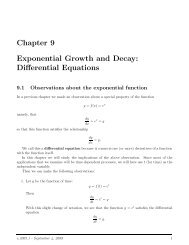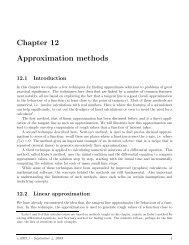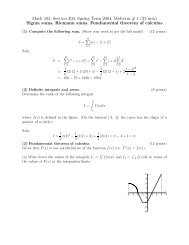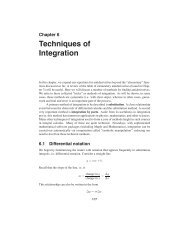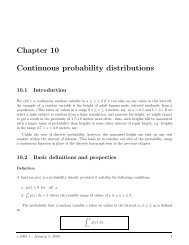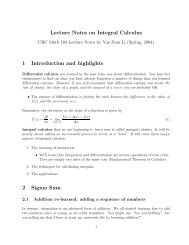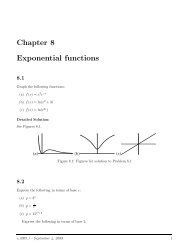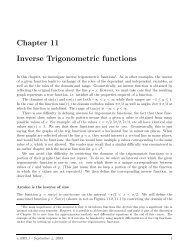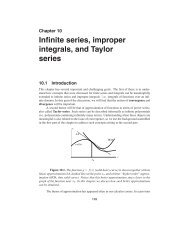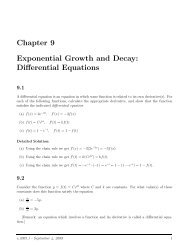Chapter 10 Trigonometric functions - Ugrad.math.ubc.ca
Chapter 10 Trigonometric functions - Ugrad.math.ubc.ca
Chapter 10 Trigonometric functions - Ugrad.math.ubc.ca
Create successful ePaper yourself
Turn your PDF publications into a flip-book with our unique Google optimized e-Paper software.
Math <strong>10</strong>2 Notes <strong>Chapter</strong> <strong>10</strong><br />
without units, whereas the quantity a has units of time, same as t. When φ = 2π, (which is the<br />
same as the <strong>ca</strong>se that a = 2π/ω, the graph has been moved over to the right by one full period.<br />
(Naturally, when the graph is so moved, it looks the same as it did originally, since each cycle is<br />
the same as the one before, and same as the one after.)<br />
Some of the s<strong>ca</strong>led, shifted, sine <strong>functions</strong> described here are shown in Figure <strong>10</strong>.6.<br />
<strong>10</strong>.5 Rhythmic processes<br />
Many natural phenomena are cyclic. It is often convenient to represent such phenomena with one<br />
or another simple periodic <strong>functions</strong>, and sine and cosine <strong>ca</strong>n be adapted for the purpose. The idea<br />
is to pick the right function , the right frequency (or period), the amplitude, and possibly the phase<br />
shift, so as to represent the desired behaviour.<br />
To select one or another of these <strong>functions</strong>, it helps to remember that cosine starts a cycle (at<br />
t = 0) at its peak value, while sine starts the cycle at 0, i.e., at its average value. A function that<br />
starts at the lowest point of the cycle is − cos(t). In most <strong>ca</strong>ses, the choice of function to use is<br />
somewhat arbitrary, since a phase shift <strong>ca</strong>n correct for the phase at which the oscillation starts.<br />
Next, we pick a constant ω such that the trigonometric function sin(ωt) (or cos(ωt)) has the<br />
correct period. Given a period for the oscillation, T, re<strong>ca</strong>ll that the corresponding frequency is<br />
simply ω = 2π . We then select the amplitude, and horizontal and verti<strong>ca</strong>l shifts to complete the<br />
T<br />
mission. The examples below illustrate this process.<br />
Example 1: daylight hours<br />
In Vancouver, the shortest day (8 hours of light) occurs around December 22, and the longest day<br />
(16 hours of light) is around June 21. Approximate the cyclic changes of daylight through the<br />
season using the sine function.<br />
Solution:<br />
On Sept 21 and March 21 the lengths of day and night are equal, and then there are 12 hours<br />
of daylight. (Each of these days is <strong>ca</strong>lled an equinox). Suppose we <strong>ca</strong>ll identify March 21 as the<br />
beginning of a yearly day-night length cycle. Let t be time in days beginning on March 21. One<br />
full cycle takes a year, i.e. 365 days. The period of the function we want is thus<br />
and its frequency is<br />
T = 365<br />
ω = 2π/365.<br />
Daylight shifts between the two extremes of 8 and 16 hours: i.e. 12 ± 4 hours. This means that the<br />
amplitude of the cycle is 4 hours. The oscillation take place about the average value of 12 hours.<br />
We have decided to start a cycle on a day for which the number of daylight hours is the average<br />
value (12). This means that the sine would be most appropriate, so the function that best describes<br />
the number of hours of daylight at different times of the year is:<br />
( ) 2π<br />
D(t) = 12 + 4 sin<br />
365 t<br />
where t is time in days and D the number of hours of light.<br />
v.2005.1 - September 4, 2009 8



